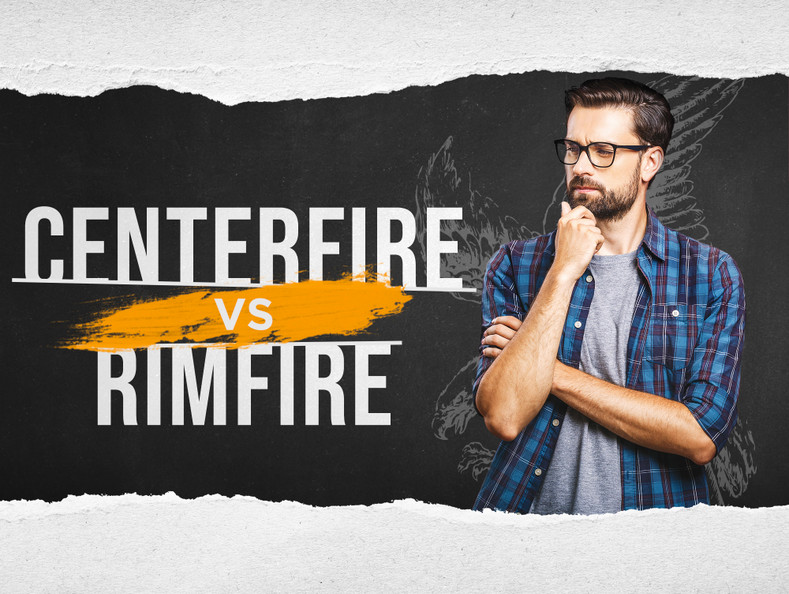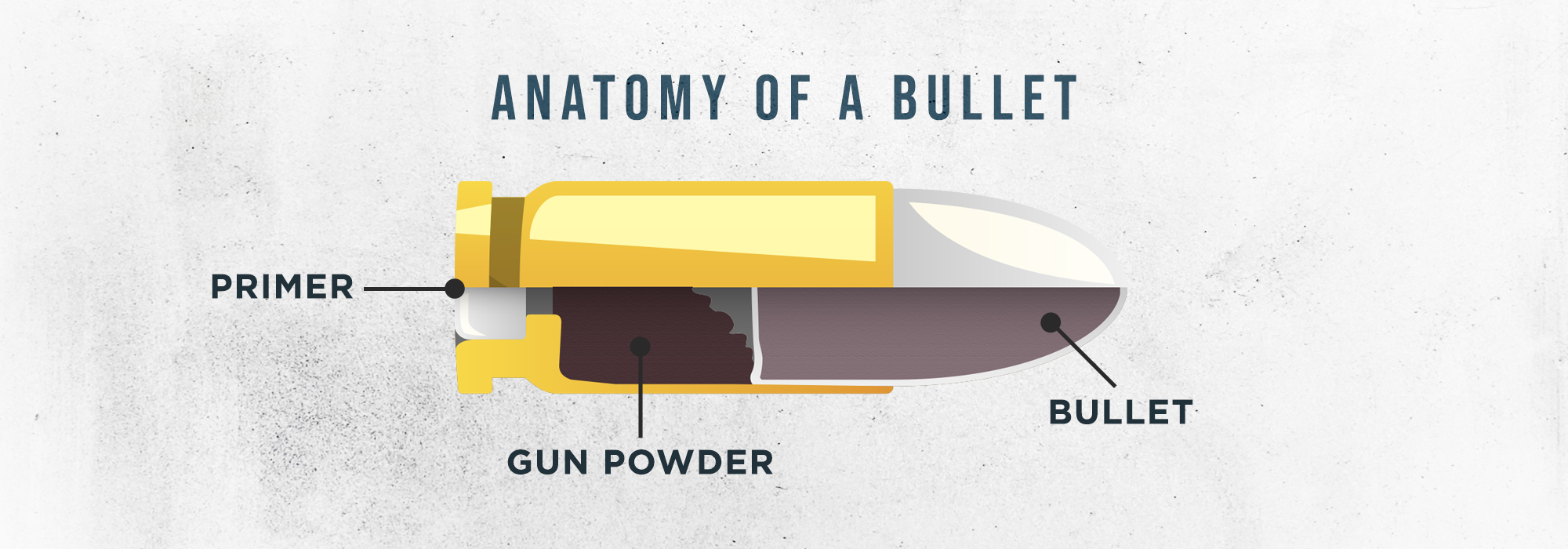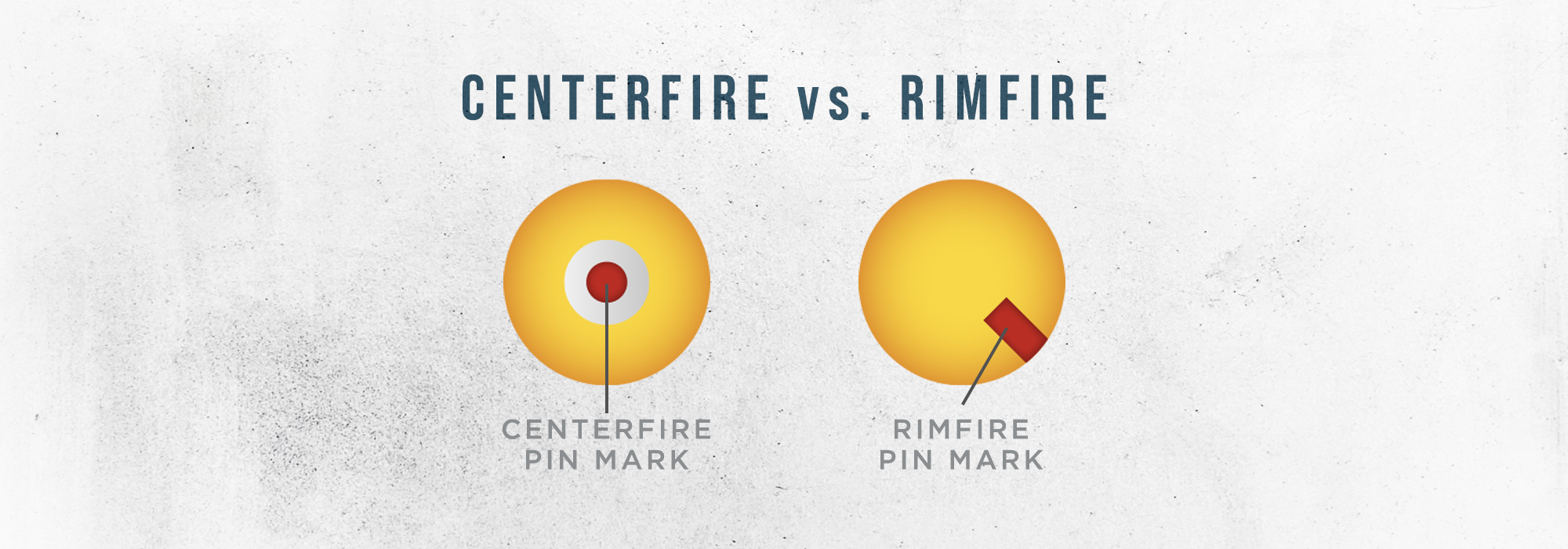Centerfire vs Rimfire Ammo: What’s the Difference?

If you’re new to the firearms world, you’ve probably heard a lot of terms about cartridges and their designs. If you’re still confused about what some of these mean, don’t worry!
In the contemporary world, two types of cartridges are often used: rimfire and centerfire. But what’s the difference, and what does it mean for you?
The difference between centerfire vs rimfire has to do with the design of the cartridge. Centerfire ammo has a primer centered in the bottom of the casing, while rimfire does not. Centerfire rounds also tend to be higher pressure than rimfire, making them a more popular choice for self-defense.
While both cartridges have their place, modern firearms and those that will be made in the future will likely make heavier use of centerfire over rimfire in most applications.
Anatomy of a Cartridge
Because cartridge design can be fairly technical, we’ll start out with a brief section defining some of the more commonly (mis)used terms when discussing ammunition design so you can better understand the difference between centerfire and rimfire.
Bullet: The bullet is the projectile that comes out of the end of the barrel after the cartridge has been fired. This is just the projectile itself and does not include the casing or primer, despite what (far too many) movies and television shows display leaving the barrel of a firearm.
Casing: A casing contains all the other parts of the cartridge. Typically, a bullet is placed in the top of the casing and crimped in place. Inside the casing, there is gunpowder, which is ignited by the primer.
Primer: a primer is a small piece of propellant seated at a specific point at the end of the casing. The primer is what the firing mechanism of the gun strikes to start the small explosion that then ignites the gunpowder. That explosion is what fires the bullet from the cartridge, down the barrel, and out of the gun at a high rate of speed.
Firing Pin: a firing pin is the part of a firearm that hits the striker, setting off the chain reaction that eventually fires the bullet. This is sometimes also called a striker, depending on the design of the firearm, but the general mechanical purpose is the same whatever this part is called.
Next, we’ll break down the differences between these two types of ammo, and talk about the rimfire vs centerfire pros and cons.

What is Centerfire Ammo?
Centerfire rounds are the most common type of cartridge for defensive, offensive, and hunting purposes. If you were to go to any battlefield from roughly World War I to the present, you will see the ground littered with spent cartridges with a little hole dented into the bottom where the primer used to be.
History
Centerfire cartridges can be traced back to an 1808 design from Switzerland. Of course, there were many firearms still in use from before that date, and it took the American Civil War, and the accompanying purchase of millions of small arms, for centerfire cartridges to see widespread adoption by the end of the 1860s. Since then, centerfire cartridges have become the global standard of ammunition design.
Design
In centerfire rounds, the primer is centered in the bottom of the casing. So, to start the reaction that sets off the round, the striker simply has to hit the middle of the cartridge. This design is the standard of what we think of today as a modern cartridge. Through the many, many sizes, shapes, and mechanisms of contemporary firearms, the centerfire design is something of a constant.
Pros
When compared to its historical predecessors, one of the biggest advantages that the centerfire, metallic cartridge has is that it can get relatively wet. Older paper cartridges, for example, were useless if they got wet at all.
Compared to rimfire cartridges, centerfire cartridges tend to be easier to reload because the primers are in the center of the case and are pretty easy to remove.
Cons
Because centerfire calibers tend to be larger than rimfire ones, centerfire rounds usually have more felt recoil, which can discourse especially small or new shooters. That increase in size also means an increase in the brass and lead used, making centerfire rounds more expensive than rimfire cartridges.
Those two cons alone are some of the main reasons that small, rimfire-chambered rifles are still so popular well into the 21st century. More on that next.
What is Rimfire Ammo?
Although not commonly used in hunting or defensive applications, rimfire cartridges are still extremely popular. These lower-powered cartridges might seem quaint and antiquated in comparison to centerfire ammo but are actually the newer of the two designs.
History
According to Todd Woodward’s excellent book “Cartridges of the World,”rimfire ammo is actually newer than centerfire. The first rimfire cartridge concepts date back to 1845, a design by a man named Louis-Nicolas Flobert. Several decades later. The now-ubiquitous .22 Long Rifle was first sold with a rifle chambered in the caliber in 1887 by J. Stevens arms.
Design
Rimfire cartridges do not have centered primer. Instead, rimfire cases have a cavity that sits around the rim of the entire cartridge (which makes the cartridge widest at its base with a small rim). That cavity is filled with primer. To ignite the primer, the firing pin must simply strike at any point along the rim. This design relies on a thin case so that the striker can dent the thinned-out section on the rim sufficiently to detonate the primer.
Pros
One of the biggest pros of rimfire ammunition today is that it is extremely cheap in comparison to other bullets. It is still possible, even in today’s market of inflated ammunition prices, to find.22 Long rifle for just a few cents per round, making it an extremely popular choice for folks who just want to enjoy shooting or are training new shooters.
Rimfire ammunition is also generally lower in pressure, and thus also has very little felt recoil. This makes rimfire an excellent choice for people who want to get into shooting for the first time.
Cons
Because of that cavity in the bottom of the case where the primer sits, rimfire cartridges have to be low pressure. While that means nice, low recoil for shooters, it also very much limits the velocity and bullet weights possible in rimfire cartridges. This makes most rimfire calibers unsuitable for self-defense or hunting except for exceptionally small game such as squirrels.
Since firing a rimfire round dents the case itself in an area that is already thin, and the rounds are so cheap new, very few reloaders bother with the time and effort it takes to reload these cartridges.

Centerfire vs Rimfire: Which is Better?
So, when it comes to rimfire vs centerfire, which is better? Frankly, the answer is that they are both good designs for their intended purposes, and each of them has a place in any firearms collection.
A rimfire .22 is often someone’s first gun, and I think there are excellent reasons for that. For folks looking to shoot a lot, it’s a great caliber that won’t bruise your wallet or your shoulder. Centerfire may result in a lot more recoil, but that comes with a lot more kinetic energy going down range, which is what you want for self-defense.
There’s a special consideration to be made for some rimfire revolvers, too. While I generally would not advise people to use .22 LR or .22WMR for self-defense, these exceptionally light recoiling rounds are perfect for someone who has low hand strength or is especially sensitive to recoil.
That’s not a clear answer, though. So, to make things as spelled out as I can: rimfire cartridges are great for training and having fun at the range, but the higher pressures and velocities from centerfire cartridges make the latter a better choice for hunting and self-defense most of the time.
Summary
When it comes to centerfire vs rimfire ammunition, the best choice for you depends on your intended use and experience level.
If you’re looking for a round for home defense or concealed carry, the more popular centerfire cartridge will likely be best for you. If you’re new to firearms or looking for a nice plinking ammo with low recoil, rimfire is an excellent choice!
Either way, if you’re looking for a new pistol that shoots either of these ammunition types, you’ll need a new holster to take with you to the range. If you’re looking for a new IWB, OWB, or pocket carry holster, visit our Holsters by Gun Model page for Kydex holsters that are custom-made for your weapon of choice.
Interested in items beyond holsters? Check out our Resources Page for links to recommended products like lights, lasers, first aid, maintenance, and more, and browse our selection of apparel, and accessories at our website, vedderholsters.com.
To stay up-to-date on all the latest Vedder Holsters content and offerings, check out our blog and follow us on Facebook, Instagram, and Twitter. And be sure to visit our sister company, GeoGrit, for all of your American-made minimalist wallet needs.
